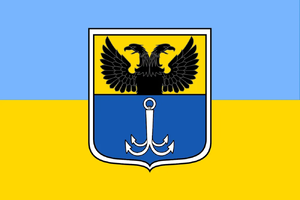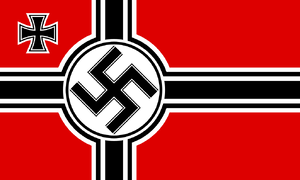Transnistria Governorate
The Transnistria Governorate is an occupied territory of the Kingdom of Romania located between the Dniester and Southern Bug rivers, conquered by the Axis Powers from the Soviet Union in World War II. It also borders Reichskommissariat Ukraine to the east.
Background
Conquest of Transnistria 1940-1945
Romania joined the Axis in November 1940 and joined Germany in its invasion against the Soviet Union during Barbarossa, in order to exact revenge against the “Soviet Empire”. Romania had suffered a series of territorial losses the previous summer, Northern Transylvania to the Hungarians, Southern Dobrudzha to the Bulgarians and Bessarabia to the Soviet Union. Despite the Germans overseeing these territorial losses, the Romanian government aligned with them, as the Soviets were seen as the larger threat and the British as being too far away.
In Tighina, a Romanian delegation represented by General de Brigadă Nicolae Tătăranu and a German delegation represented by Generalmajor Arthur Hauffe met to discuss the terms of the Romanian occupation of Transnistria, this would subsequently result in the Tighina Agreement being signed on the 30th of August 1941, containing 9 articles. Gheorghe Alexianu was appointed as governor of Transnistria.
Romanian forces had crossed the Dniester river and continued their campaign towards the southern Bug. The Romanians had swiftly captured the territory but the Soviets had successfully established a defense of Odessa and Romanians had to besiege the city. Romanian losses in the battle of Odessa reached a staggering 90k (18k dead, 63k wounded, and 9k missing). The losses at Odessa represented an unsustainable 26.5% of the total forces engaged there, 340,223 men out of 583,930 men of the entire Romanian ground forces. The high Romanian casualties dampened the Romanian people's support for the war and the Romanian General Staff assessed that the morale of the troops were considerably lower in Transnistria than in Bessarabia and Bukovina. This is because the rationale of invading Transnistria itself was beyond them, while Bessarabia and Bukovina were worth the battle. Romania was one of the main participants on the eastern front, and the government was responsible for the persecution and massacre of up to 260,000 Jews.
Other political movements within Romania opposed the occupation of Transnistria based on the grounds that it was not part of “national Romania”; the leaders of the PNT and PNL declared that "the Romanian people will never consent to the continuation of the struggle beyond our national borders."
Over time the Romanian military's brutal treatment of partisans in Transnistria would lead to their decline. The Romanian adminstration would at times trap the partisans so they would starve, forcing them to resort to cannibalism, which would then be publicized on newspapers to discredit the partisan cause.
Occupation of Transnistria 1945-1955
The intention of the Antonescu government was to colonize and eventually annex Transnistria, but such an annexation would have to happen after the reconquest of North Transylvania. Such colonizations were to begin around the Dniester Valley and these areas were to be settled by the Eastern Romanians (also known as “Moldovans”). These Eastern Romanians spoke Romanian differently compared to their counterparts in Romania, due to decades of distance, with some Eastern Romanians even using the cyrillic alphabet. The policy during the Famine of 1946, caused by a frost and prolonged drought, would cause the population of Ukrainians to decline, as the Romanian government seized grain to feed Romanians.
Collaboration in the territory with the Ukrainian populace would remain virtually non-existent. Relations between the Romanian administration and Ukrainians were tense, with the Romanians believing that every Ukrainian was at their heart a nationalist sympathizing with the OUN. The Romanian installed mayor of Odesa Gherman Pântea was far more successful in encouraging collaboration from the Ukrainians. The Russian intelligentsia and Romanian administration would be on far better terms though.
New governor (1956-1963)
As a result of the Alba Iulian March of 1956, the Romanian government led by Gheorghe I. Brătianu would give into the demands of the National Peasants' Party and resign, resulting in King Michael forming a new interim military led government by Gheorghe Avramescu. Alexianu would see this as a violent overthrow and refuse to recognize the new government, hoping to win German support to overthrow the Romanian government. Germany would not be interested, the Romanian and German military jointly stormed the Governor's office and arrest Alexianu. The borders with RK Ukraine managed by the Germans collapsed as a result of the rebellions occurring there, resulting in Ukrainian partisans and insurgents establishing a new foothold in Transnistria.
A new military administration in Transnistria was appointed by the Avramescu government, led by Gheorghe Potopeanu. Tasked with stabilizing the situation, Potopeanu loosened the previously harsh policies of the Alexianu administration and began a counter-insurgency operation. The insurgency would once again begin to die down, but unlike the Second World War, their presence continued to be significant. Potopeanu, who was disinterested in governing Transnistria, was replaced with a new civilian administration led by the director-general of the Special Intelligence Service, Victor Siminel. During this time the colonization of Transnitria completely ended, and no new settlers were permitted to arrive, all plans to annex the entire territory were permanently cancelled.
The new National Peasants' government elected in 1956 would wish to abandon Transnitria, but due to security concerns and Romania's commitment to the Tighina agreement, this could not happen. The result was that the Romanian government would increasingly reduce the military presence in Transnistria.
Transnistria War (1964-1967)
The relatively new government of Nicolae Penescu will be faced with a major crisis in Transnistria, as the collapse of the Reichskommisariat Ukraine results in a new wave of insurgents flowing into Romania, effectively re-activating the dormant insurgency in the region and causing an explosion in violence.
The UPA will use the Odesa catacombs to launch attacks on Odesa itself, resulting in several bombings occurring in the lead up to an attempted seizure of several government buildings in Odesa. While most of these attacks fail, the insurgents will seize control of a VoMi office (HQ of Area Command XXV of the Sonderkommando R) and take hostages, causing Romania to have to prepare a rescue mission with German support. This leads to thehe Mayor of Odesa, Gherman Pântea, to declare a state of emergency in the city.
The Odesa hostage crisis will result in the Germans taking the decision to evacuate their local population to Saporoschje region. Planning and preparations will take place once the VoMi office has been retaken and will be conducted as soon as the Ukrainian Civil War is over.
The Romanian presence in Transnistria is unpopular at home and Penescu is unable to leave the region due to Romania’s treaty commitments with Germany. He will have to partially adopt Sabin Manuilă’s ideas for Transnistria and negotiate with Smochinâ to try and establish a narrative for the Romanian people that this operation is to protect the local Romanian population in Transnistria. Siminel will quickly resign and be Grigore Baștan or Gherman Pântea depending on the Romanian government.
Once the situation in Odesa stabilizes, administration can return to normal, though the insurgency will continue in the countryside. UPA activity in Odesa will lower the general security in other parts of the territory and Communist Partisans up in the North will use the opportunity to seize villages and towns. The Communist partisans will be successfully wiped out in COIN operations by the Romanian army, but the UPA settles down and continues to conduct terrorist attacks both in Transnistria and Romania proper.
Establishment of a new administration (1968-1969)
The Tighina Agreement will be renegotiated and the Germans will leave the territory, the Romanians will reform the government in Transnistria to be under control of local Ukrainians. Due to limited previous collaboration and upcoming elections in Romania in 1968, this process will take a while. After the Romanian elections, a Pridnestrovian Rada will be established. Nicolae Penescu, Gheorghe Zane and Ion Rațiu will establish a local Pridnestrovian Republic, while Mihail Fărcășanu will establish an ad-hoc Administration named the ”Administration Between the Dniester and Bug.”
While the new administration is being established, Romania will hold a referendum in the Dubăsari, Tiraspol, Ovidiopol, Râbnița and Ananiev județ regarding the annexation of these 5 counties into Romania proper, with a decade of colonization of lands that already had a considerable Romanian minority will have resulted in these counties having a Romanian majority. The city of Odesa may be included in the referendum depending on the government’s decision.
If Radu Câmpeanu comes to power in Romania in 1968, he will make the decision to evacuate Transnistria entirely, leaving the territory for the Germans to occupy, ending two decades of Romanian rule. Germans will establish a military administration, which will be a rather chaotic period for the region.
Flags
| Flags | |||
|---|---|---|---|
| Flag | Country Name | Ideologies | Notes |
| Transnistria Governorate | |||
| Pridnestrovian Republic Administration between the Dniester and Bug |
Pridnestrovie independence | ||
| Gebeit des Militärbefehlshabers in Transnistrien | German takeover | ||



